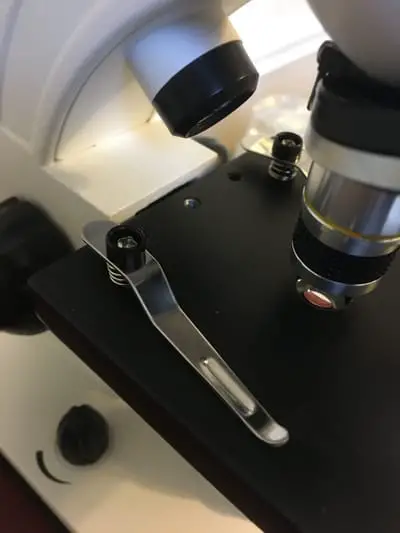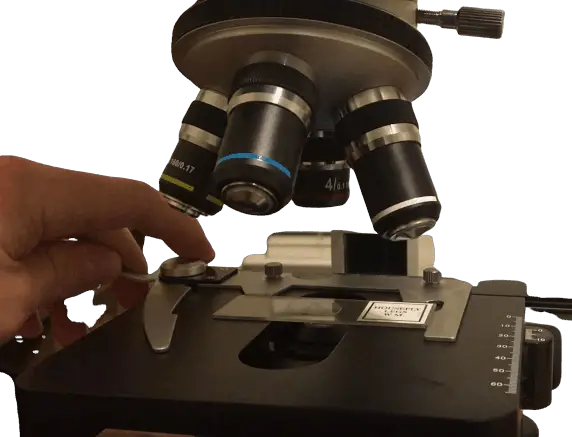If you’ve been to a Broadway show, any school, or community theater production, you know what a stage is, and you know the purpose of a stage. It’s where all the actors perform, where all the action happens, and the story is told. So what is a microscope stage and what is the function?
The stage of a microscope is the aluminum or iron platform where the specimen, usually on a glass slide, is raised or lowered for observation under the microscope. Microscope stages will often include stage clips that will hold the slide in place while the stage is being adjusted up and down or side to side.
The specimen in microscopy is where all the action happens and where the story is told. In this article we will look at different types of stages and identify traits and characteristics of each.
Simple Stage
Visually the easiest way to identify a simple stage is by the stage clips which are usually spring loaded and just lift and hold a slide in place. If the slide needs to be adjusted it must be manually done by the observer’s fingers pushing the slide up, down, or side to side while still clipped. For this reason, simple stages are often not desirable under high magnification because it is difficult to make slight movements with a slide manually without inadvertently moving the specimen out of the field of view.
The simple stage will usually have a couple of locking and stopping mechanisms. A stage lock control allows you lock the stage in place to prevent movement after focusing your image.
Simple stages will typically ship with a rack stop feature which can be adjusted to prevent the stage from moving too close to the objective lenses. If the stage moves too close to the objective lens the lens can be easily damaged and become non-functional.

Mechanical Stage
The mechanical stage is so named because slide movements are controlled by a mechanical system mounted to the stage. The mechanical stage clamps, instead of clips, onto the slide and movement along the X (side to side) and Y (up and down) axis of the stage is controlled by knobs that can more precisely move the slide into position.
The mechanical stage knobs allow the user to make extremely slight movements of the slide by slightly turning the knobs instead of relying on manually movements by hand. This allows the observer to not only find the specimen quicker but to keep the specimen in the field of as magnification increases.
There are mechanical stage attachments that can be mounted to simple stages with some slight modifications to the simple stage including removing the standard stage clips.
Circular Stage
The circular stage allows even more flexibility and precision than the simple and mechanical stage because it can rotate 360 degrees. Typically, circular stages come with stage clips but there is a mechanical attachment that can be mounted to it that give you the benefits of a mechanical stage and the benefits of 360 degree orations. Note that some of the mechanical stage attachments can prevent the full 360 degree motion so be sure to check to make sure the attachment you get does not impede the movement too much.
The circular stage also has two centering knobs that help to ensure the specimen is completely centered under the objective lens and does not leave the field of view as the specimen is rotated and as the higher magnification objective lenses are selected.
The stage swivels on ball bearings to do require some upkeep to ensure the swivel motion is smooth and precise.
Inverted Microscope Stage
The inverted stage is very similar to the mechanical stage in that it can also control slide movements through knobs that move the slide along the X and Y axis, but the inverted stage has a larger opening in the stage. The larger opening allows larger samples to be placed on the stage.
I should note that the reason an inverted microscope is called “inverted” is because the objectives are below, and the light source is above, opposite to a standard compound light microscope. The way the inverted microscope focuses is a combination of movement from the nosepiece and objective lens. This means that the stage does not run the risk of crashing into the objective lens like a typical light microscope.
Precision Measurement Stage
Precision measurement stages are used with a measuring microscope. The stage itself can range from 50 X 50 to 300 X 300 millimeters. These stages are typically used for quality testing purposes for components in high technology fields that require very small pieces.
These stages are usually equipped with a rotatable stage plate that allows 360 degree movement and edge detection capabilities that allow measurements to be taken from any point.
Micromanipulators Stage
Micromanipulator stages are ones that have two hydraulically controlled micromanipulators built to and configured with the stage. The manipulators and the stage can be configured to accommodate several specific angles and avenues of manipulation of the specimen.
The micromanipulators are used to interact and manipulate a sample with movements that are precise to the submicron scale. They are used in various scientific avenues that include circuit engineering, specialized engineering, biology, and optics. Examples include invitro fertilization experiments, genetic implantation procedures, and tissue sampling.
Universal Stage
Fixed flat stages can offer only so much in terms of sample positioning and orientation. When examining liquids and layered rock samples or crystals often there is a need to change the orientation of the sample to many different positions. To accomplish this without massive time wasting reconfiguration of existing stages, a universal stage is used.
A universal stage can rotate 360 across three, four, or even five axes, although four is the most common. This gives the observer free range of just about any axes and angle one could need during observation. One thing to note is that the universal stage often requires a significant distance between the specimen and the objective, so magnification is limited to an extent.
Stereo Microscope Stage
Unlike a compound light microscope where light is condensed into a cone of light and focused up through a hole in the stage, the stereo microscope stage is transparent and a bulb light source shines light directly through the transparent stage plate.
Stereo microscope stages typically do not come with a mechanical stage because specimens used under stereo microscopes are much larger and can easily be manipulated by hand.
Electron Microscope Stage
The electron microscope stage is nonmagnetic and is built to be used in a vacuum environment. Theses stages are built with a piezoelectric actuator that is used for nano-positioning of the specimen.
For more on electron microscopes see Electron Microscopes Explained: From Physics to Images.
Takeaways
Microscope stages come is varying shapes, sizes, and functionalities but they all have one thing in common; they hold the specimen for observation. No matter what stage you are using in your microscopic endeavors, the stage will be where the story is told and where new and exciting things are learned and observed.
I hope this quick look at different microscope stages has given you a sense for the different uses and applications of these different types of stages.

